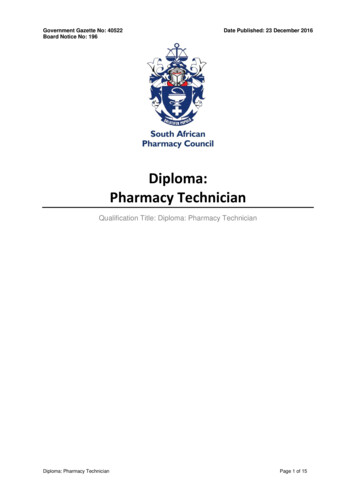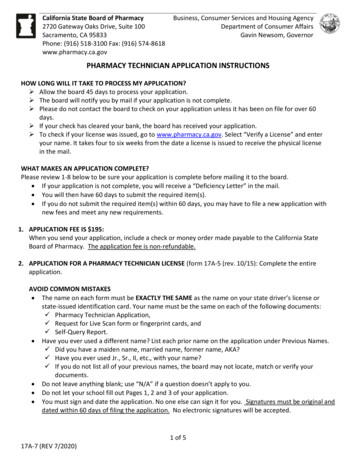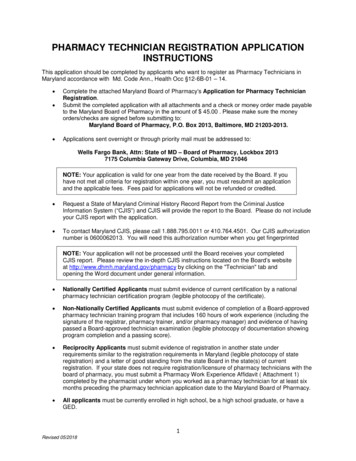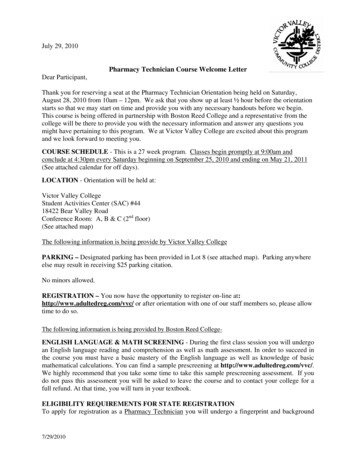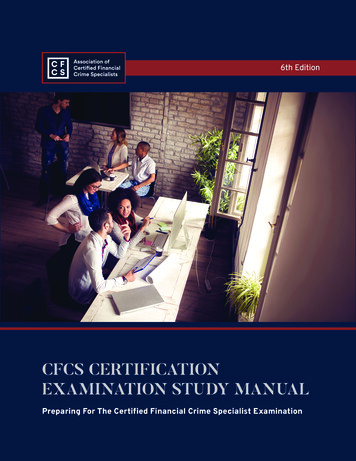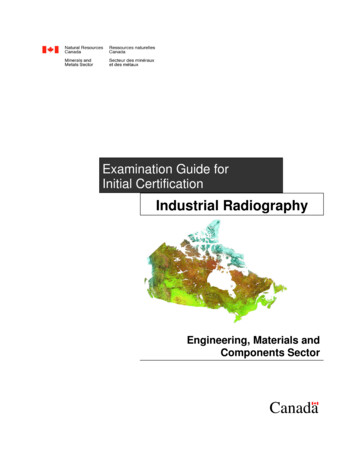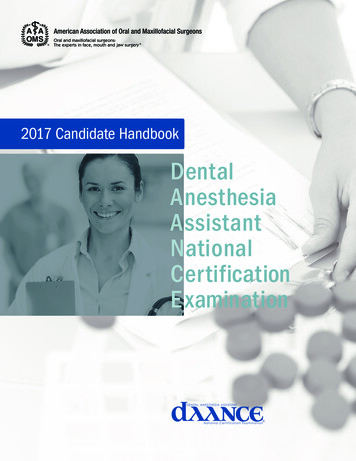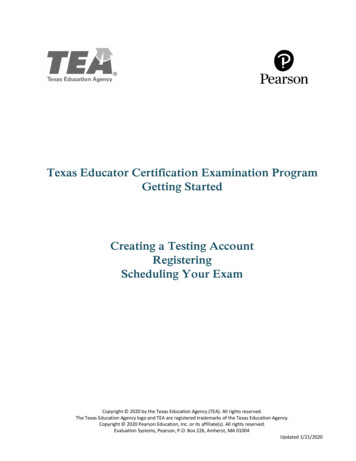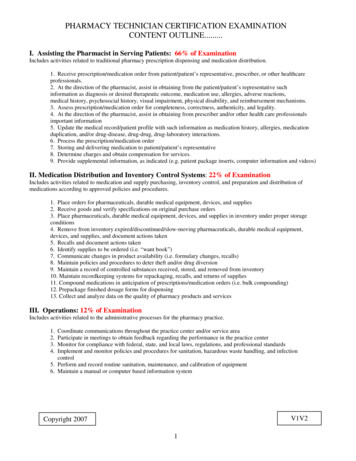
Transcription
PHARMACY TECHNICIAN CERTIFICATION EXAMINATIONCONTENT OUTLINE.I. Assisting the Pharmacist in Serving Patients: 66% of ExaminationIncludes activities related to traditional pharmacy prescription dispensing and medication distribution.1. Receive prescription/medication order from patient/patient’s representative, prescriber, or other healthcareprofessionals.2. At the direction of the pharmacist, assist in obtaining from the patient/patient’s representative suchinformation as diagnosis or desired therapeutic outcome, medication use, allergies, adverse reactions,medical history, psychosocial history, visual impairment, physical disability, and reimbursement mechanisms.3. Assess prescription/medication order for completeness, correctness, authenticity, and legality.4. At the direction of the pharmacist, assist in obtaining from prescriber and/or other health care professionalsimportant information5. Update the medical record/patient profile with such information as medication history, allergies, medicationduplication, and/or drug-disease, drug-drug, drug-laboratory interactions.6. Process the prescription/medication order7. Storing and delivering medication to patient/patient’s representative8. Determine charges and obtain compensation for services.9. Provide supplemental information, as indicated (e.g. patient package inserts, computer information and videos)II. Medication Distribution and Inventory Control Systems: 22% of ExaminationIncludes activities related to medication and supply purchasing, inventory control, and preparation and distribution ofmedications according to approved policies and procedures.1. Place orders for pharmaceuticals, durable medical equipment, devices, and supplies2. Receive goods and verify specifications on original purchase orders3. Place pharmaceuticals, durable medical equipment, devices, and supplies in inventory under proper storageconditions4. Remove from inventory expired/discontinued/slow-moving pharmaceuticals, durable medical equipment,devices, and supplies, and document actions taken5. Recalls and document actions taken6. Identify supplies to be ordered (i.e. “want book”)7. Communicate changes in product availability (i.e. formulary changes, recalls)8. Maintain policies and procedures to deter theft and/or drug diversion9. Maintain a record of controlled substances received, stored, and removed from inventory10. Maintain recordkeeping systems for repackaging, recalls, and returns of supplies11. Compound medications in anticipation of prescriptions/medication orders (i.e. bulk compounding)12. Prepackage finished dosage forms for dispensing13. Collect and analyze data on the quality of pharmacy products and servicesIII. Operations: 12% of ExaminationIncludes activities related to the administrative processes for the pharmacy practice.1.2.3.4.Coordinate communications throughout the practice center and/or service areaParticipate in meetings to obtain feedback regarding the performance in the practice centerMonitor for compliance with federal, state, and local laws, regulations, and professional standardsImplement and monitor policies and procedures for sanitation, hazardous waste handling, and infectioncontrol5. Perform and record routine sanitation, maintenance, and calibration of equipment6. Maintain a manual or computer based information systemV1V2Copyright 20071
Are You Ready? ChecklistTo Do Complete registration with PTCB and pick a test date.Purchase Study Material Study Manual Math Workbook Advanced Math Problems Practice ExamsWhat are the differences between a Prescription and a Medication OrderWhy is a Patient Profile important to completeWhen do you know when to refer a patient to a pharmacistLatin AbbreviationsAbsorption, Distribution, Metabolism, Elimination definitionsDosage formsNDCsExpiration DatesUnit dosesFractions, Decimals, and Roman NumeralsConversionsAlligationsCelsius and FahrenheitFlow RatesWeights that Class A,B and Analytical balances can weigh accuratelyTypes of Mortars and what each is forDefinitions of Levigation, Trituration, Punch MethodDifferences between Conical and graduated Cylinders and how to measureAntibioticsCardiovascularsGI MedsRespiratory MedsDiabetesAnalgesicsBlood Disorder MedsPsychotherapeutic MedsHormonesHIV/AIDSTopicalsAuxiliary LabelsAseptic Technique’s dos and don’ts How to clean How to correctly operateDifferences between Horizontal and Vertical Flowhoods Where the filter is located Direction of airflow Which one to use with hazardous materialsSyringes/Needles – Names and critical sitesDifferences between vials and ampoulesIVs and Injections2
TPNsAntineoplasticsDistribution and Inventory Identify Robotic names Formulary System Inventory Systems Purchasing Choices Returns Drug RecallsComputer TerminologyLaw FDA Regulates who Durham-Humphrey Kefauver-Harris PPIs Poison Prevention Packaging Act Occupational and Safety Act Poison Log Requirements Controlled Substance Act DEA Identification Amount of Refills allowed Limitations of Pharmacy Technician Repackaging Requirements OBRA DEA FormsClassroom Quiz 1 and 2Review Past Exam QuestionsQ&AsMath WorkbookAdvanced Math ProblemsPractice Exams 1,2,3,and 4Get a good nights sleepBring pencils and a non-programmable calculatorAlso use the syllabus as a checklist 3
“What is the definition of a prescription?”A prescription is an order for a medication issued by a licensed medical practitioner.For example: Physician, dentist, veterinarian, podiatrist, physician assistant, and nursepractitioner.A prescription is required if the medicine requires medical supervision. The drug is unsafewithout medical supervision.A prescription medication is required by the manufacturer to print on the stock bottle:“Caution, Federal Law prohibits dispensing without a prescription.”A prescription may come in different forms:- Written form from the office- The office may telephone in the prescription (Only RPhs and Interns are allowed to take) No CIIs- The office is allowed to fax in the prescription (with an exception: CIIs)- The office may transmit through the computer (electronic prescriptions) NO CIIsA prescription is different from a medication order in that: A prescription is an order given to the patientto have filled and a medication order is medications written by the physician in an institution (hospital)and kept on one sheet of paper in the patients file for the whole hospital staff to use. See example onpage 8.Technicians may do refill requests. They must provide the following information to the doctor’s office:1. Pharmacy name and Phone Number2. Patient name and Date of Birth3. Drug Name, Strength, and Quantity4. Directions to confirm no change5. Date of the last refill4
ASSESSING ORDER COMPLETENESSElements of a PrescriptionEvery medication order and prescription should contain the following elements: Patients name Name of drug (generic or brand) Route of Administration Dosage form - Only required if the medicine comes in more than one form Dose Strength - Only required if the medicine has more than one strength available Quantity and frequency of administration Prescriber’s name and signature Prescriber’s Drug Enforcement Agency (DEA) number – for controlled substances only Date written Refill informationAdditional information that is included on inpatient orders (hospital) includes: Rate or time of administration Allergy information Account number Admission number Room and bed location Time of day written Diagnosis Patients diet Indication for use of the medicationLabeling MedicationsPrescription Label RequirementsUnder the Food, Drug, and Cosmetic Act (FDCA), the prescription label must have the following information: Name and address of the pharmacy Serial number of the prescription (Rx number) Date of the prescription or its date of filling or refilling Name of the prescriber Name of the patient Directions for useState law may further require the following: Address of the patient Initials or name of the dispensing pharmacist Telephone number of the pharmacy Drug name, strength, and manufacturer’s lot or control number Expiration date of the drug Name of the manufacturer Amount of the drug dispensed Refill information5
Elements of a LabelPlace all the requirements of a prescription label from memory.If the medication is a controlled substance, the label must state, “Caution, Federal Law prohibits the transfer of this drug toany person other than the patient for whom it was prescribed.”DO NOT COVER THIS UP WITH AN AUXILARY LABEL.“Who regulates what goes on a prescription label?” Answer: FDAFDA Requirements:1. Name of Pharmacy2. Address of the Pharmacy3. Rx Number4. Date of filling5. Name of the Patient6. Directions of Use7. Address of the Patient8. Initials of dispensing Pharmacist9. Phone number of Pharmacy10. Drug Name, Strength, Form, and Quantity11. Expiration Date12. Manufacturer13. Refill Information6
Elements of a PrescriptionLabel all the requirements of a prescription.Draw your own prescription with the following information.1. Patients name2. Name of Drug3. Route of Administration – If the route is missing, the patient might not take it as you assume.4. Dosage Form- only needed if the drug comes in more than one form.5. Dose6. Strength – Only needed if the drug comes in more than one strength.7. Quantity8. Prescriber’s name printed on the prescription9. Prescriber’s signature10. Date written11. Refill information – if the refill spot is blank then a zero must be placed on the label.12. DEA number of the prescriber – only needed if the medication is a controlled substance.7
Example of a Medication OrderTake notice that ALLinformation is on this onesheet. This is a medicationorder in an institution(hospital). Diagnosis (Dx),condition of patient, allergies,diet, and medications. Timesand room numbers areimportant in a hospital.8
Patient ProfilesA patient profile includes a list of all the prescriptions received by a patient and all of the corresponding prescriptioninformation (e.g. original date, refill dates, doctor information). Active medications should be listed first, and theyshould be separated from the discontinued medications. Also, O-T-C medications should also be listed for thepharmacist to monitor interactions.The following information is usually found in a patient profile: Patient name and identification number Date of birth or age Sex Height and weight - hospital use Diagnosis or health conditions Name of parent or guardian Patient address and phone number. Names of practitioners (e.g. physicians, dentists, podiatrists) Medication allergies Third-party payer information Medication history (current, old, and OTC) Special considerations (foreign language) Clinical comments (e.g. therapeutic monitoring, counseling notes) Desired therapeutic outcome – what does the doctor hope to accomplish?Referring Patients to a PharmacistIt is very important for technicians to know when to answer a patient’s question and when to refer the patient to thepharmacist. Technicians SHOULD NOT interpret a patient-specific question or provide information that may requireprofessional judgment.The technician is not the one to tell the patient that they need to see a doctor .that is the pharmacist’s job.There are three reasons why technicians should always refer patients with drug (even OTCs) or health-related questionsto a pharmacist:1. Drug-Drug InteractionsThe patient may be taking prescription or other nonprescription drugs that may interact with OTC medication.For example, drugs used for heartburn and acid indigestion interact with heart disease, blood pressure, and seizuredisorders.Aspirin and Coumadin (warfarin) interact and could cause internal bleeding.2. Drug-Disease State InteractionsSome nonprescription drugs may worsen the patient’s existing disease state.Sudafed (pseudoephedrine) worsens high blood pressure and diabetes therefore should not be taken.3. Drug-Food InteractionsThe absorption of ketoconazole and nitrofurantion increases when taken with fatty foods.The absorption of Tetracycline, Cipro, Phenytoin decreases when taken with any food.Grapefruit interacts with Calcium Channel Blockers and estrogens.Warfarin interacts with food high in Vitamin K (spinach and romaine)4. Need for Physician ReferralPharmacists have their limits. The pharmacists are the ones with the knowledge of knowing when the condition requiresmedical attention.9
10
Common Latin AbbreviationsYou only need to memorize these to pass the exam. Make flashcards.Abbreviationaaaacadad libadasamaubidcddtdf,ft.gttgttshhsMMft.nonoctnon rep, idUt dict , ud, utdMeaningbeforeof eachbefore mealsup toas much as desiredright earleft earbefore noonboth earstwice dailywithgivegive such dosesmakedropdropshourat bedtimemixmix and makenumbernightno refillsright eyeleft eyeboth eyesafterafter mealsby mouthafter noonrectallyas neededeveryevery dayevery other dayevery 2 hoursevery 4 hoursfour times dailyquantity sufficientsublingual (under the tongue)1/2directionsnow3 times dailyas directed11
Write out the following directions in a complete sentence.i gtt ou bid x 7 di appl vag qhsi tab po qid pciss tsp po tid prn coughiv gtts ad q 4 h prn paini cap po tid ac hsi tab sl prn chest painii tab po qodii stat, i tab qid x 10 di supp pr q 6 h prn nauseai – ii caps po q 4-6 h prn pHow many tablets should be dispensed for a 30 day supply? i tab qid x 1 day, i tab tid x 2 days, i tabbid x 3 days, then i tab qd thereafter.Answers: Insert one drop into both eyes twice daily for 7 days. , Insert one applicatorful vaginally every night at bedtime. ,Take one tablet by mouth four times a day after a meal. , Take one and one-half teaspoonful by mouth 3 times a day asneeded for cough. , Insert 4 drops into right ear evry 4 hours as needed for pain. , Take one capsule by mouth three times aday before a meal and again at bedtime. , Dissolve one tablet under the tongue as needed for chest pain. , Take two tablets bymouth every other day. , Take two tablets immediately then one tablet four times a day for 10 days. , Insert one suppositoryrectally every 6 hours as needed for nausea. , Take one or two capsules by mouth every 4 to 6 hours as needed for pain. ,(1x4x1) (1x3x2) (1x2x3) 16 tablets in 6 days, that leaves 24 days left in the month at taking one tablet once a day to bean additional 24 tablets added to 16 tablets 40 tablets in 30 days.Memorize the following DefinitionsAbsorption- Drug gets absorbed into the bloodstreamDistribution- Drug goes to where it is neededMetabolism- Drug is broken down by the liverElimination- Excretion from the body12
Dosage FormsSolid Dosage FormsA. Tablets1) Most popular dosage form2) Prepared by mechanical compression3) Dissolution must be dissolved in the stomach before it can elicit its pharmacological effectB. Chewable tablets1) chewed and dissolved in the mouth prior to swallowing2) they also can be swallowed wholeC. Enteric-coated tablets - Will be on the test1) special coating over tablet to prevent the dissolution within the stomach.2) these tablets are meant to dissolve in the intestines only.3) should NEVER be chewed, broken or crushed prior to ingestion.4) not to be taken with antacids which cause dissolution in the stomachD. Sublingual tablets - Will be on the test1) placed “under the tongue” where the active ingredient is quickly absorbed into the bloodstream---absorption is not in the GI tract2) only small amounts of drug are needed3) avoids the “first pass” effect - this is where the drug circulates throughout the body before it isbroken down in the liver (metabolized)E. Buccal tablets1) “between cheek and gum”2) drug is dissolved slowly over a period of timeF. Film-coated tablets - Will be on the testBiaxin and Depakote are examples.1) special coating that masks the objectionable odor or taste2) prevents deterioration due to light and airG. Sustained, timed-release tablets1) active ingredient is released at a constant rate for a prolonged period of time2) “long-acting”, “delayed-release”, “prolonged-action”H. Lozenges1) “troches or pastilles”2) meant to dissolve slowly in the mouth to keep the drug in contact with the mouth or throat longerI. Pellets1) cylinder shaped tablets for implantation just under the skin for continuous drug absorptionJ. Capsules - Will be on the test1) drug is enclosed within a gelatin shell.2) after 10 to 30 minutes with the stomach, the gelatin capsule dissolves and the drug is released3) eliminates bad tastes and odors of drugsK. Effervescent tablets1) active ingredient sodium bicarbonate citric acid (or tartaric acid) acid/base reaction causes a releaseof carbon dioxide gas effervescence2) masks the taste of unpleasant, salty, or bitterness of medication13
Syrups- Think SUGARHigh concentrations of sugar hinders bacteria growth.Examples: antibiotics, cough preparationsSolutions (Soln) – drug is uniformly dispersed throughout the liquid. (it doesn’t settle to the bottom)Therefore there is no need for a shake well sticker. If you hold the liquid up to the light you will not seeany drug floating around. Example: Albuterol SolutionSuspensions (Susp)- The medication is insoluble in the liquid. (does not dissolve)If you hold this liquid up to the light you will see little particles floating around and then settle.These medications require a shake well sticker because the medication settles at the bottom and thepatient will not get the correct dose if not shaken. Example: Bactrim SuspensionElixer- sweetened water with alcohol. If the medication is an elixir, it contains alcohol. Not for babies.Tinctures- highest concentration of alcohol. This will be on the test.National Drug Code (NDC)- Every prescription medication has this. It is devised of 3 sets of numbers.1. The first set of numbers refers to - the manufacturer and is usually 5 numbers2. The second set of numbers refers to – the drug name and strength and is usually 4 numbers3. The last set of numbers refers to what – the package size and is usually 2 numbers.For example:00535-0934-05This will be on the test.Expiration Dates- All medication has an expiration date. If the medication expires on 11-09 then the exact time itwill expire is the last day of the month at midnight. So, in this case this medication expires on November 30th,2009 at midnight.50% Rule: The repackaged vial or unit dose must have an expiration date placed on it; but it is not the same expiration dateas what is on the stock bottle. You must take the date on the stock bottle and write the half way date between today’s dateand the expiration date. But if the expiration date on the stock bottle is years and years, there is a max of one year that youwrite on the repackaged item.Unit dose: Medication is dispensed in single unit packages in sealed, sanitary, ready-to-administer doses.Only a 24 hour supply is dispensed in the hospital. “Why?”Because of these Advantages:1. Medication errors reduced2. Control over medication is increased3. Drug waste is minimized. Drug can be returned to stock if not used.4. Less preparation time.5. Billing is more accurate for the patient. The patient only pays for what was used.Labeling requirements for Unit Dose:1. Drug name, strength, dosage form2. Lot number (in case of recalls)3. Expiration date4. Directions5. Auxiliary labels6. Storage and cautions7. Manufacturer8. Repackaging date14
Fractions to DecimalsReducing fractions to lowest termsFind the largest number that can be divided evenly into both the numerator and denominator. Largefractions may need to be reduced several times.Example 1:Reduce 1524Example 2:Reduce 189 Divide both top and bottom by 3 to equal 63/72 which can be reduced216 again by dividing by 9 to equal 7/8Example 3:Reduce 3 Divide both top and bottom by 3
Limitations of Pharmacy Technician Repackaging Requirements OBRA DEA Forms Classroom Quiz 1 and 2 Review Past Exam Questions Q&As Math Workbook Advanced Math Problems Practice Exams 1,2,3,and 4 Get a good nights sleep Bring pencils and a non-programmable calculator Also use the syllabus as a checklistFile Size: 2MB



